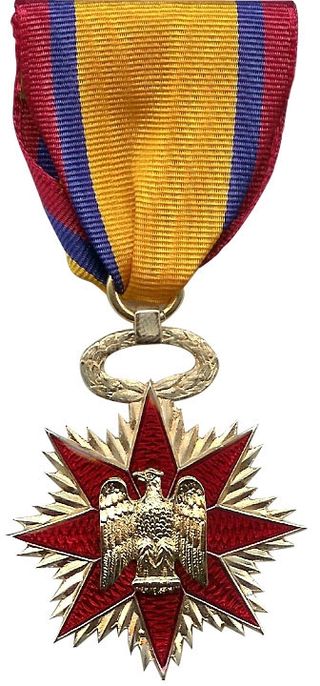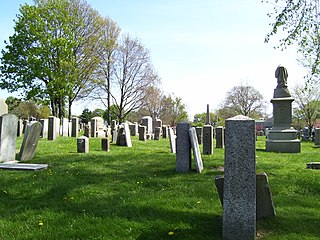
George Harris, 1st Baron Harris GCB was a British soldier.
The Military Order of the Loyal Legion of the United States (MOLLUS), or, simply, the Loyal Legion, is a United States military order organized on April 15, 1865, by three veteran officers of the Union Army. The original membership was composed of commissioned officers of the Regular or Volunteer Army, U.S. Navy, or U.S. Marine Corps who served during the American Civil War, or who had served and thereafter been commissioned and who thereby "had aided in maintaining the honor, integrity, and supremacy of the national movement" during the Civil War.

West Point Cemetery is a historic cemetery on the grounds of the United States Military Academy in West Point, New York. It overlooks the Hudson River, and served as a burial ground for Continental Army soldiers during the American Revolutionary War, and for early West Point residents prior to its designation as a military cemetery in 1817.
The 15th Wisconsin Infantry Regiment was a volunteer infantry regiment that served in the Union Army during the American Civil War. It was popularly known as the Norwegian Regiment or the Scandinavian Regiment, due to its composition of mostly Norwegian American, Swedish American, and Danish American immigrants.

John Irvin Gregg was a career U.S. Army officer. He fought in the Mexican–American War and during the American Civil War as a colonel and near the end of the war as a brevet general in the Union army. In 1866, he was nominated and confirmed as a brevet major general of volunteers and a brevet brigadier general in the Regular Army, both to rank from March 13, 1865.

The Military Order of Foreign Wars of the United States (MOFW) is one of the oldest veterans' and hereditary associations in the nation with a membership that includes officers and their hereditary descendants from all of the Armed Services. Membership is composed of active duty, reserve and retired officers of the United States Armed Services, including the Coast Guard, National Guard, and allied officers, and their descendants, who have served during one of the wars in which the United States has or is engaged with a foreign power.
The 22nd Regiment Illinois Volunteer Infantry was an infantry regiment that served in the Union Army during the American Civil War.
The 27th Indiana Infantry Regiment was an infantry regiment that served in the Union Army during the American Civil War.

The Common Burying Ground and Island Cemetery are a pair of separate cemeteries on Farewell and Warner Street in Newport, Rhode Island. Together they contain over 5,000 graves, including a colonial-era slave cemetery and Jewish graves. The pair of cemeteries was added to the National Register of Historic Places as a single listing in 1974.

Fort Wright was constructed in 1861 and located on the second Chickasaw Bluff at Randolph, Tipton County, Tennessee. Fort Wright was a Civil War fortification and the first military training facility of the Confederate Army in Tennessee.

The Choctaw in the American Civil War participated in two major arenas—the Trans-Mississippi and Western Theaters. The Trans-Mississippi had the Choctaw Nation. The Western had the Mississippi Choctaw. The Choctaw Nation had been mostly removed west prior to the War, but the Mississippi Choctaw had remained in the east. Both the Choctaw Nation and the Mississippi Choctaw would ultimately side with the Confederate States of America.
The 50th Ohio Infantry Regiment was an infantry regiment in the Union Army during the American Civil War.
Hispanics in the American Civil War fought on both the Union and Confederate sides of the conflict. Not all the Hispanics who fought in the American Civil War were "Hispanic Americans" — in other words citizens of the United States. Many of them were Spanish subjects or nationals from countries in the Caribbean, Central and South America. Some were born in what later became a U.S. territory and therefore did not have the right to U.S. citizenship. It is estimated that approximately 3,500 Hispanics, mostly Mexican-Americans, Puerto Ricans and Cubans living in the United States joined the war: 2,500 for the Confederacy and 1,000 for the Union. This number increased to 10,000 by the end of the war.
The following Union Army units and commanders fought in the Battle of Belmont of the American Civil War. The Confederate order of battle is listed separately.
The 13th Arkansas Infantry (1861–1865) was a Confederate Army infantry regiment during the American Civil War. Organized mainly from companies, including several prewar volunteer militia companies, raised in northeastern Arkansas, the regiment was among the first transferred to Confederate Service, and spent virtually the entire war serving in Confederate forces east of the Mississippi River. After the unit sustained heavy casualties during the Battle of Murfreesboro, the unit spent most of the rest of the war field consolidated with the 13th Arkansas Infantry Regiment, to form the 5th/13th Arkansas Infantry Regiment.

Tyree Harris Bell was a Confederate States Army brigadier general, during the American Civil War.

Thomas Moore Scott was a Confederate States Army brigadier general during the American Civil War. He saw active service in several battles in the Western Theater of the American Civil War. He was a planter before and after the war.
The Catawba in the American Civil War participated in the Eastern Theater. From the very beginning, the Catawba allied themselves with the Confederacy, remaining loyal until the end of the War. They enrolled with the 5th, 12th, and 17th South Carolina Infantry Regiments.

The 21st Louisiana Infantry Regiment, also called the McCown Regiment, was an infantry regiment from Louisiana that served in the Confederate States Army during the American Civil War. Six of its companies formed the 5th Louisiana Infantry Battalion organized in September 1861, which fought in the Battle of Belmont as cannoneers. The battalion was brought up to regimental strength, becoming the 21st Louisiana, by the addition of four companies in February 1862. After service at Island Number Ten, Fort Pillow, and the Siege of Corinth, the regiment was disbanded due to its high desertion rate.

The 12th Louisiana Infantry Regiment was a unit of volunteers recruited in Louisiana that fought in the Confederate States Army during the American Civil War. Formed in August 1861, the regiment served in the Western Theater of the American Civil War and was unique in that there were 12 companies. The regiment garrisoned Island Number Ten before being stationed at Fort Pillow. It fought at Second Corinth in 1862 and Champion Hill and Jackson in 1863. A detachment served during the Siege of Vicksburg and was captured. In 1864, the regiment fought in the Meridian, Atlanta, and Franklin–Nashville campaigns, suffering heavy losses at Peachtree Creek and Franklin. It fought at Bentonville in 1865 before surrendering with General Joseph E. Johnston.









